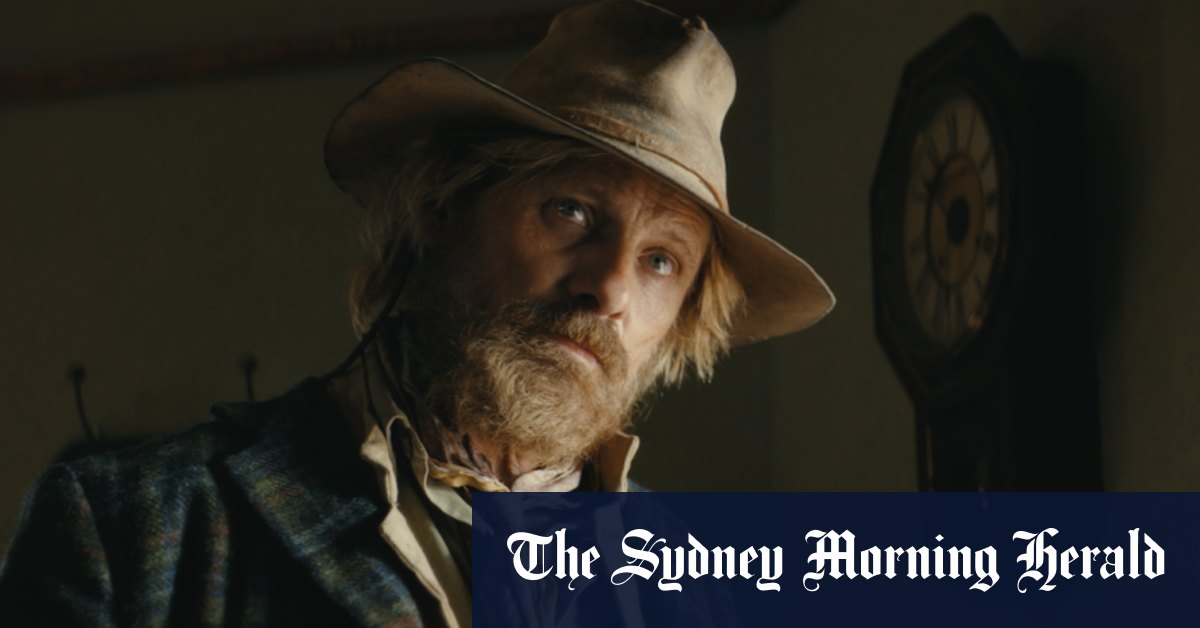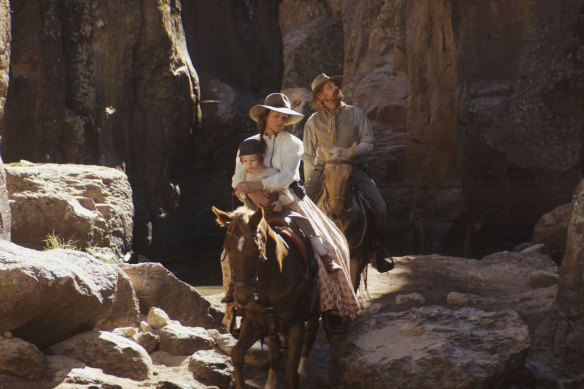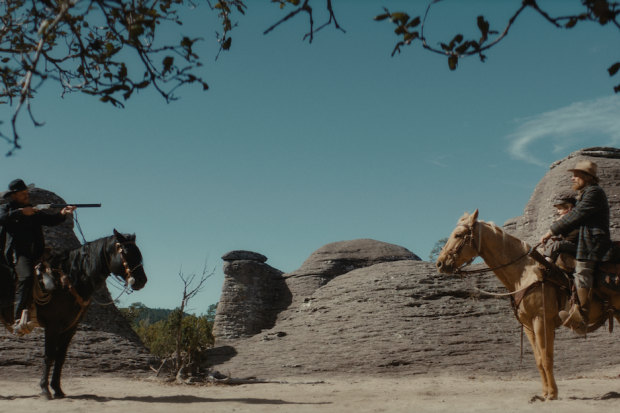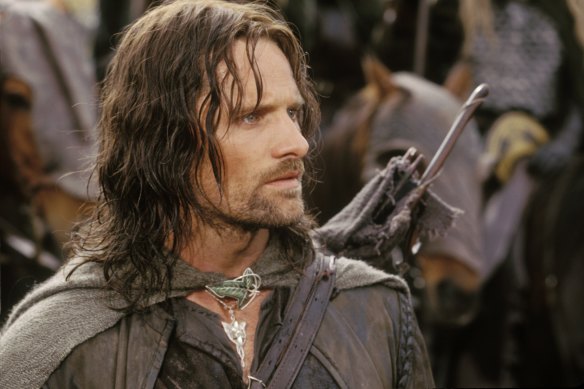
The first thing we see in Viggo Mortensen’s The Dead Don’t Hurt is a knight in shining armour riding on horseback through lush green woods.
And that, more or less, was the first thing Viggo Mortensen saw before setting out to write what would become his second film as director.
“Usually as I’m writing, I start with an image,” he says from Madrid, where he spends much of his time. He also has a home in Los Angeles and family in Denmark. “In this case, it was an image of this little girl running around in the forest, big imagination, a stubbornly independent little girl. I thought, ‘Well, who’s this person going to become’.”
The little girl – who encounters the knight of her imagination more than once over the course of the story – becomes Vivienne (Vicky Krieps, of Phantom Thread fame), the unconventional woman at the heart of this most unconventional Western.
The story that began to take shape was inspired in part by Mortensen’s mother. And making it a Western – a genre he has always loved – felt like a good way of upping the stakes.

Vivienne (Vicky Krieps) and Olsen (Mortensen) ride with their son through the frontier land they’ve settled in.Credit: Marcel Zyskind
“For a woman who’s free-spirited and independent-minded, very much her own person, it’ll be that much harder for her to be in a place that’s lawless and dominated by a few corrupt men who aren’t averse to using violence to achieve their goals,” he says. “It’ll be harder for her to be herself. I just wanted to tell a story about this woman.”
Young Vivienne, the daughter of French immigrants to the New World, is obsessed with the idea of chivalry and the story of Joan of Arc. And therein lies a clue to her arc: she starts off seeking a knight in shining armour – a need that becomes more acute once her father rides off to fight the English in the northern frontier, never to return – but ends up becoming her own saviour.
“Vicky is such a great actress, with or without words, she gets across so much,” says Mortensen, who also plays the male lead, a fellow immigrant called Olsen, and composed the score.
Vivienne and Olsen meet on the waterfront after she’s walked out on her blowhard wealthy lover, and in the blink of an eye they are in bed together. Soon after that, she’s riding off to a new life with him, only to find when she gets to his little patch of paradise that it’s a lot more hard-scrabble than she’d anticipated.

Vicky Krieps stars as Vivienne, an uncommonly resourceful (in Westerns, if not in real life) frontierwoman. Credit: Marcel Zyskin
When Olsen’s sense of chivalry kicks in and he rides off to join the Union side in the Civil War, Vivienne is left to fend for herself. It’s years before he returns, to a much-changed woman and world.
“Generally in the history of Westerns, almost never is a woman the main character,” says Mortensen. “And if they are, they are extraordinary women – extremely beautiful, rich landowners, powerful. Or sometimes in exploitation-type Westerns, a woman will act like a violent man and grab a weapon and shoot all the bad guys, or something like that.
“But if you’re talking about a traditional, classic Western, it’s very unusual to have a woman be the lead, and it’s even more unusual – to the point, I would say, that never do you see it – that a man goes off to war and you stay with her.
“We’re doing those things. They are quite different. But the look and feel of the movie is, hopefully, like a classic, old-fashioned Western.”
It is that. But it also looks fresh, in no small part because of where it was shot, in Durango, Mexico. Though the state had been used for Westerns back in the 1960s and ’70s, its landscapes are likely to strike most viewers as both fresh and remarkable. The movie’s climactic scene in particular looks like it could have been shot on another planet, so unusual are the rock formations that frame the action.
There’s one other sense in which Mortensen’s movie differs from the standard Western: its main characters are immigrants.

The Mexican state of Durango provided many of the remarkable landscapes in the movie.Credit: Marcel Zyskin
“I wasn’t trying to make any political point,” he insists. “I was just saying, ‘Well, that’s just the way it was’.”
Sure. But whether you were trying to make a political statement or not, given the current climate, it can’t help but do so.
“Yeah, and that’s OK,” says Mortensen. “People read lots of things, some intended, some not, into what they see. And I think that’s great.
“I make the movie I want to see, and then when you or someone else sees it, it’s a different movie, because they’re bringing their associations, their upbringing, their movie-going experience, everything that has happened in their lives to it, and it becomes a different story. It’s a strange alchemy, and I like that it becomes someone else’s movie.
“Sometimes the comments are very pointed – ‘Oh, this is obviously a reflection of what’s happening in politics in the United States, or political corruption, economic disparities, racism, misogyny, etc’. Yeah, maybe. That’s all valid.
“Honestly, no matter what your intentions are, if the characters are well acted, the story is more or less well written, and the situations you’re seeing involve real obstacles, conflicts, points of view that sometimes clash, sometimes connect, no matter what time period it’s set in you’re going to connect it to your family or your town, your society. It’s just a natural thing when you believe what you’re seeing on screen.”
Mortensen started writing the film during lockdown, but he’s been beavering away on screenplays since his 20s. “The first time I tried to get a movie made that I would direct was from a script I wrote in the early 1990s,” he says. “I found some financing. It was a story set in Scandinavia, it was a silent movie, about 1000 years ago.”
He chuckles at the memory. He had some of the finance in place, but not enough, and back then his name meant nothing when it came to convincing people to invest.
“And then I started working more as an actor, so I kind of put it to one side. But I kept writing other scripts, I wanted to direct, but it took me another 25 years before I ended up directing Falling.”
His first outing as director, released in 2020, was about the tense relationship between a gay man and his father. It was a low-budget movie, but even so, he didn’t have the money fully in place when he started – and even then, what he did have was contingent upon the Lord of the Rings star acting in it.
He wasn’t going to be in this one either, but when his leading man fell out of the picture late in the piece he had little choice but to step in (at least he had a pretty good sense of the dialogue, having written it, and of the character’s motivation).

Playing Aragon in the Lord of the Rings movies helped make Mortensen one of the more bankable actors on the planet.
He’s happy with the result, he says, and having not started in the director’s chair until he was almost 60, he’s much more tolerant than he would have been at 35.
“I’m a bit more lenient when I watch movies that almost work. I don’t know what happened that day, why that scene doesn’t quite work. Who knows who influenced that – producers, circumstances, the actor had a bad day. I’m much more forgiving as an audience member.
“It’s not easy to make any kind of movie, good or bad. It’s very hard to make a movie that is true to itself and holds together from start to finish. Very difficult.”
The Dead Don’t Hurt is in cinemas from December 5.



